Loop Service
The Loop Service is a streetcar circle route in Portland, Oregon, United States, that runs as part of the Portland Streetcar system. Operated by Portland Streetcar, Inc. and TriMet, it consists of two distinct services: the 6.1-mile (9.8 km) A Loop, which runs clockwise, and the 6.6-mile (10.6 km) B Loop, which runs counterclockwise. Each service travels a loop between the east and west sides of the Willamette River, crossing it on the Broadway Bridge in the north and Tilikum Crossing in the south. The route connects Portland's downtown, Pearl District, Lloyd District, Central Eastside, and South Waterfront. It serves the city's various landmarks and institutions, including the Rose Quarter, the Oregon Convention Center, the Oregon Museum of Science and Industry (OMSI), Oregon Health & Science University (OHSU), and Portland State University (PSU).
| Loop Service | ||||||||||||||||||||||||||||||||||||||||||||||||||||||||||||||||||||||||||||||||||||||||||||||||||||||||||||||||||||||||||||||||||||||||||||||||||||||||||||||||||||||||||||||||||||||||||||||||||||||||||||||||||||||||||||||||||||||||||||||||||||||||||||||||||||||||||
|---|---|---|---|---|---|---|---|---|---|---|---|---|---|---|---|---|---|---|---|---|---|---|---|---|---|---|---|---|---|---|---|---|---|---|---|---|---|---|---|---|---|---|---|---|---|---|---|---|---|---|---|---|---|---|---|---|---|---|---|---|---|---|---|---|---|---|---|---|---|---|---|---|---|---|---|---|---|---|---|---|---|---|---|---|---|---|---|---|---|---|---|---|---|---|---|---|---|---|---|---|---|---|---|---|---|---|---|---|---|---|---|---|---|---|---|---|---|---|---|---|---|---|---|---|---|---|---|---|---|---|---|---|---|---|---|---|---|---|---|---|---|---|---|---|---|---|---|---|---|---|---|---|---|---|---|---|---|---|---|---|---|---|---|---|---|---|---|---|---|---|---|---|---|---|---|---|---|---|---|---|---|---|---|---|---|---|---|---|---|---|---|---|---|---|---|---|---|---|---|---|---|---|---|---|---|---|---|---|---|---|---|---|---|---|---|---|---|---|---|---|---|---|---|---|---|---|---|---|---|---|---|---|---|---|---|---|---|---|---|---|---|---|---|---|---|---|---|---|---|---|---|---|---|---|---|---|---|---|---|---|---|---|---|---|---|---|
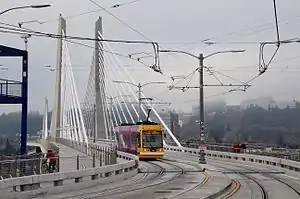 A B Loop streetcar on Tilikum Crossing in 2015 | ||||||||||||||||||||||||||||||||||||||||||||||||||||||||||||||||||||||||||||||||||||||||||||||||||||||||||||||||||||||||||||||||||||||||||||||||||||||||||||||||||||||||||||||||||||||||||||||||||||||||||||||||||||||||||||||||||||||||||||||||||||||||||||||||||||||||||
| Overview | ||||||||||||||||||||||||||||||||||||||||||||||||||||||||||||||||||||||||||||||||||||||||||||||||||||||||||||||||||||||||||||||||||||||||||||||||||||||||||||||||||||||||||||||||||||||||||||||||||||||||||||||||||||||||||||||||||||||||||||||||||||||||||||||||||||||||||
| Other name(s) |
| |||||||||||||||||||||||||||||||||||||||||||||||||||||||||||||||||||||||||||||||||||||||||||||||||||||||||||||||||||||||||||||||||||||||||||||||||||||||||||||||||||||||||||||||||||||||||||||||||||||||||||||||||||||||||||||||||||||||||||||||||||||||||||||||||||||||||
| Status | Operational | |||||||||||||||||||||||||||||||||||||||||||||||||||||||||||||||||||||||||||||||||||||||||||||||||||||||||||||||||||||||||||||||||||||||||||||||||||||||||||||||||||||||||||||||||||||||||||||||||||||||||||||||||||||||||||||||||||||||||||||||||||||||||||||||||||||||||
| Owner | City of Portland | |||||||||||||||||||||||||||||||||||||||||||||||||||||||||||||||||||||||||||||||||||||||||||||||||||||||||||||||||||||||||||||||||||||||||||||||||||||||||||||||||||||||||||||||||||||||||||||||||||||||||||||||||||||||||||||||||||||||||||||||||||||||||||||||||||||||||
| Locale | Portland, Oregon, U.S. | |||||||||||||||||||||||||||||||||||||||||||||||||||||||||||||||||||||||||||||||||||||||||||||||||||||||||||||||||||||||||||||||||||||||||||||||||||||||||||||||||||||||||||||||||||||||||||||||||||||||||||||||||||||||||||||||||||||||||||||||||||||||||||||||||||||||||
| Stations | 52 | |||||||||||||||||||||||||||||||||||||||||||||||||||||||||||||||||||||||||||||||||||||||||||||||||||||||||||||||||||||||||||||||||||||||||||||||||||||||||||||||||||||||||||||||||||||||||||||||||||||||||||||||||||||||||||||||||||||||||||||||||||||||||||||||||||||||||
| Service | ||||||||||||||||||||||||||||||||||||||||||||||||||||||||||||||||||||||||||||||||||||||||||||||||||||||||||||||||||||||||||||||||||||||||||||||||||||||||||||||||||||||||||||||||||||||||||||||||||||||||||||||||||||||||||||||||||||||||||||||||||||||||||||||||||||||||||
| Type | Streetcar | |||||||||||||||||||||||||||||||||||||||||||||||||||||||||||||||||||||||||||||||||||||||||||||||||||||||||||||||||||||||||||||||||||||||||||||||||||||||||||||||||||||||||||||||||||||||||||||||||||||||||||||||||||||||||||||||||||||||||||||||||||||||||||||||||||||||||
| System | Portland Streetcar | |||||||||||||||||||||||||||||||||||||||||||||||||||||||||||||||||||||||||||||||||||||||||||||||||||||||||||||||||||||||||||||||||||||||||||||||||||||||||||||||||||||||||||||||||||||||||||||||||||||||||||||||||||||||||||||||||||||||||||||||||||||||||||||||||||||||||
| Services | 2 | |||||||||||||||||||||||||||||||||||||||||||||||||||||||||||||||||||||||||||||||||||||||||||||||||||||||||||||||||||||||||||||||||||||||||||||||||||||||||||||||||||||||||||||||||||||||||||||||||||||||||||||||||||||||||||||||||||||||||||||||||||||||||||||||||||||||||
| Operator(s) | Portland Streetcar, Inc.TriMet | |||||||||||||||||||||||||||||||||||||||||||||||||||||||||||||||||||||||||||||||||||||||||||||||||||||||||||||||||||||||||||||||||||||||||||||||||||||||||||||||||||||||||||||||||||||||||||||||||||||||||||||||||||||||||||||||||||||||||||||||||||||||||||||||||||||||||
| Daily ridership |
| |||||||||||||||||||||||||||||||||||||||||||||||||||||||||||||||||||||||||||||||||||||||||||||||||||||||||||||||||||||||||||||||||||||||||||||||||||||||||||||||||||||||||||||||||||||||||||||||||||||||||||||||||||||||||||||||||||||||||||||||||||||||||||||||||||||||||
| History | ||||||||||||||||||||||||||||||||||||||||||||||||||||||||||||||||||||||||||||||||||||||||||||||||||||||||||||||||||||||||||||||||||||||||||||||||||||||||||||||||||||||||||||||||||||||||||||||||||||||||||||||||||||||||||||||||||||||||||||||||||||||||||||||||||||||||||
| Opened | September 22, 2012 | |||||||||||||||||||||||||||||||||||||||||||||||||||||||||||||||||||||||||||||||||||||||||||||||||||||||||||||||||||||||||||||||||||||||||||||||||||||||||||||||||||||||||||||||||||||||||||||||||||||||||||||||||||||||||||||||||||||||||||||||||||||||||||||||||||||||||
| Technical | ||||||||||||||||||||||||||||||||||||||||||||||||||||||||||||||||||||||||||||||||||||||||||||||||||||||||||||||||||||||||||||||||||||||||||||||||||||||||||||||||||||||||||||||||||||||||||||||||||||||||||||||||||||||||||||||||||||||||||||||||||||||||||||||||||||||||||
| Line length |
| |||||||||||||||||||||||||||||||||||||||||||||||||||||||||||||||||||||||||||||||||||||||||||||||||||||||||||||||||||||||||||||||||||||||||||||||||||||||||||||||||||||||||||||||||||||||||||||||||||||||||||||||||||||||||||||||||||||||||||||||||||||||||||||||||||||||||
| Character | At-grade, mixed between street running and exclusive lane | |||||||||||||||||||||||||||||||||||||||||||||||||||||||||||||||||||||||||||||||||||||||||||||||||||||||||||||||||||||||||||||||||||||||||||||||||||||||||||||||||||||||||||||||||||||||||||||||||||||||||||||||||||||||||||||||||||||||||||||||||||||||||||||||||||||||||
| Track gauge | 4 ft 8 1⁄2 in (1,435 mm) standard gauge | |||||||||||||||||||||||||||||||||||||||||||||||||||||||||||||||||||||||||||||||||||||||||||||||||||||||||||||||||||||||||||||||||||||||||||||||||||||||||||||||||||||||||||||||||||||||||||||||||||||||||||||||||||||||||||||||||||||||||||||||||||||||||||||||||||||||||
| Electrification | 750 V DC, overhead catenary | |||||||||||||||||||||||||||||||||||||||||||||||||||||||||||||||||||||||||||||||||||||||||||||||||||||||||||||||||||||||||||||||||||||||||||||||||||||||||||||||||||||||||||||||||||||||||||||||||||||||||||||||||||||||||||||||||||||||||||||||||||||||||||||||||||||||||
| ||||||||||||||||||||||||||||||||||||||||||||||||||||||||||||||||||||||||||||||||||||||||||||||||||||||||||||||||||||||||||||||||||||||||||||||||||||||||||||||||||||||||||||||||||||||||||||||||||||||||||||||||||||||||||||||||||||||||||||||||||||||||||||||||||||||||||
Portland city officials first proposed building an eastside streetcar line in 1997, at the same time the city council authorized the construction of Portland's first modern streetcar line on the west side. After several years of planning, the city council approved the Eastside Loop extension project in 2008 and held its groundbreaking the following year. The extension's first 3.3 miles (5.3 km) opened between the Broadway Bridge and OMSI on September 22, 2012. It was inaugurated by the Central Loop Line (CL Line) service, which ran an additional 1.1 miles (1.8 km) along the original westside alignment on 10th and 11th avenues. The CL Line was re-branded to its current name in 2015 during the opening of Tilikum Crossing, which completed the streetcar loop with a southerly river crossing extension from OMSI to the South Waterfront.
History
Planning
Plans to expand the Portland Streetcar east of the Willamette River emerged in July 1997, at the same time the Portland City Council authorized the construction of the system's first line on the west side between Northwest Portland and PSU.[2] During this time, the council also voted to fund a $16.7 million retrofitting of the Hawthorne Bridge,[3] which they had hoped would carry a future eastside streetcar line between OMSI and the Oregon Convention Center as proposed by the Buckman Neighborhood Association.[2] The Hawthorne Bridge reopened in April 1999, with the outer-lane decks rebuilt to accommodate notches for rails.[4] In July 2001, the Lloyd District Development Strategy proposed another streetcar plan that sought the addition of streetcars to the Lloyd District,[5][6] which was already being served by buses and MAX Light Rail,[5]:20 to create a transit hub by adding lines on Broadway and Weidler streets and connecting with the west side via the Broadway Bridge.[5]:26[7] Concurrent revitalization efforts of nearby Rose Quarter supported this plan.[8]
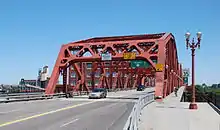
In meetings that began in February 2003, an advisory committee composed of eastside residents urged extending this proposed Broadway–Weidler alignment farther east up to 21st Avenue. Meanwhile, Portland Streetcar officials, amid TriMet plans to construct a new Willamette River bridge as part of a MAX extension to Milwaukie, suggested routing the OMSI–Oregon Convention Center proposal to this planned bridge instead of the Hawthorne Bridge.[9] The city council, with backing from Multnomah County commissioners, adopted the Eastside Streetcar Alignment Study in June 2003.[10] The study outlined a westside–eastside loop project that ran from the Pearl District across the Broadway Bridge to the Lloyd District, then south along Grand Avenue and Martin Luther King Jr. Boulevard to Hawthorne Boulevard. A southern crossing back to the west side depended upon whether the new TriMet bridge would be constructed, leaving that section undetermined at the time.[11][12]
In 2008, the steering committee for the Portland–Milwaukie light rail project selected a locally preferred alternative that included a new river crossing between the South Waterfront and OMSI near Caruthers Street;[13] this led to a decision to build the first phase of the eastside streetcar 3.3 miles (5.3 km) up to OMSI until the new bridge could be completed, after which the streetcar would cross the bridge back to the west side to form a complete loop.[14]:1[15]:2
Funding and construction
Metro regional government approved the streetcar extension in July 2006 followed by the city council in September 2007.[16][17] The total cost of the phase one project was $148.8 million (equivalent to $167 million in 2019 dollars), including the cost to purchase additional vehicles.[18]:19 Just over half would be paid for with federal funds.[19] The city council committed to allocating $27 million of city funds.[17] $20 million from the state, $15.5 million from a Local Improvement District, and a combination of various other local or regional sources completed the locally matched financing.[20] On April 30, 2009, U.S. Transportation Secretary Ray LaHood announced $75 million in federal funding for the project, the full amount that had been requested by Portland. This allocation, secured in large part through the efforts of Oregon Representatives Earl Blumenauer and Peter DeFazio, was the largest and final component of the financing plan and meant the project could proceed with construction.[21][22]
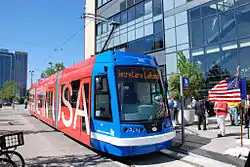
In 2005, the U.S. Congress approved a spending bill that included $4 million for a locally produced streetcar vehicle.[23] That money went to Oregon Iron Works, which created the subsidiary United Streetcar upon receiving the contract to build new vehicles for the Portland Streetcar.[24] In May 2009, United Streetcar delivered its first prototype to Portland for testing on existing tracks; it was the first U.S.-built streetcar in nearly 60 years.[25][26] That August, the city signed a $20 million contract to purchase six new vehicles from the manufacturer for the eastside extension.[27]
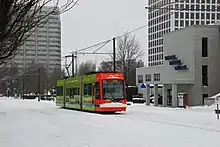
Groundbreaking for the Eastside Streetcar Loop project took place on June 25, 2009.[28] The city selected Stacy and Witbeck to be the project's general contractor and actual construction began the following year.[29] Across the alignment, crews laid tracks in three-to-four-block increments; by February 2010, they had been laying tracks on Northeast Grand Avenue.[30] Workers closed the Broadway Bridge to all traffic to be renovated from July 19 to September 3, 2010.[31][32] To maintain the existing weight of the bridge (this was necessary to allow it to continue lifting its spans) with the addition of tracks, lighter fiber-reinforced concrete replaced the deck.[33][34] In the Pearl District, sections of what had been two two-way streets—Northwest Lovejoy and Northwest Northrup—were converted into one-way streets following the addition of rails. The Lovejoy ramp on the west end of the Broadway Bridge reopened to traffic in November 2010.[35] In Southeast Portland, workers built a 425-foot-long (130 m) bridge that carried the streetcar from Southeast Stephens Street to the project's eastern terminus at OMSI.[36]
In July 2011, the city council agreed to contractual changes that reduced the number of streetcars on order from six to five due to unanticipated costs related to the cars' production.[37] United Streetcar had depended on Czech firm Škoda, which built the system's first streetcars, to build the new streetcars' propulsion system but these failed acceptance testing. Portland officials opted instead to source the propulsion system from Wisconsin-based Rockwell Automation, but Rockwell was still developing its design at the time. They then pursued Austrian manufacturer Elin to produce a propulsion system for the prototype while they awaited Rockwell. Changes to the propulsion system necessitated changes to the streetcar design in order for the streetcar to accommodate a different form factor; this ultimately delayed the project and raised the cost of manufacturing.[38]
Opening and closing of the loop
The 3.3-mile (5.3 km) eastside extension opened on September 22, 2012,[39][40]:125 after a five-month-long delay.[41] Portland Streetcar branded the new service the "Central Loop Line" (abbreviated as CL Line) and renamed the original service the "North South Line" (NS Line).[42] The CL Line ran an additional 1.1 miles (1.8 km) on 10th and 11th avenues, overlapping with the NS Line between Southwest Market Street in downtown Portland and Northwest Northrup Street in the Pearl District, before it ran to the eastside for OMSI—a total of 4.4 miles (7.1 km).[39] Service along the eastside segment initially operated with frequencies of 18 minutes instead of an originally planned 15 minutes due to funding cuts by TriMet and the City of Portland, as well as delays in streetcar delivery from United Streetcar.[43] The first car finally arrived in January 2013 and entered service on June 11, 2013.[44] Fares were $1 upon opening due to TriMet's elimination of the Free Rail Zone.[45] Approximately 3,200 riders per weekday used the line during the first two weeks of service.[46]
.jpg.webp)
The second phase of the Eastside Loop project, referred to as "Close the Loop", extended the streetcar from OMSI to the NS Line tracks on Southwest Moody Avenue in the South Waterfront.[47]:50 This phase had awaited the construction of the new Willamette River crossing.[48] That bridge, later named Tilikum Crossing, began construction in 2011.[49] Construction of the streetcar components started on August 5, 2013, with the installation of a turning loop on the intersections of Southeast Stephens Street, Grand Avenue, and Martin Luther King Jr. Boulevard. From September–November that year, crews closed the OMSI streetcar platform to install the streetcar-track connection with the Portland–Milwaukie light rail along Tilikum Crossing. This project had a total cost of $6.7 million (equivalent to $7.4 million in 2019 dollars), which included automatic train stop upgrades.[50][51]
On August 30, 2015, CL Line service was extended on the west side using existing NS Line tracks from Southwest 10th and Market streets in downtown Portland south to Southwest Moody and Meade streets in the South Waterfront.[18]:19 A new temporary schedule eliminated the name CL Line in favor of two separately named routes: "A Loop" and "B Loop". Streetcars began operating across the newly built Tilikum Crossing, but without carrying passengers across the bridge, during a two-week transitional "pre-revenue service" phase.[52] The line was formally re-branded as the "Loop Service" on September 12, 2015,[53]:2–13 when Tilikum Crossing opened to the public and began permitting streetcars to carry passengers on the route section across the bridge.[54][55]
Service
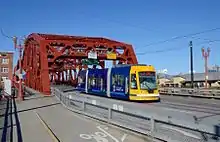
The Loop Service operates from 5:30 am to 11:30 pm on weekdays, from 7:30 am to 11:30 pm on Saturdays, and from 7:30 am to 10:30 pm on Sundays. Headways in each direction range from 15 minutes between 10:00 am and 7:00 pm on weekdays and Saturdays to 20 minutes for all other times. Traveling a complete loop in either direction takes just under one hour.[56][57] In September 2018, the A Loop carried 3,612 riders on weekdays while the B Loop carried 3,064 riders.[58]
Route
The Loop Service is a circle route that runs between downtown Portland and the Central Eastside.[59] It consists of two services: the 6.1-mile (9.8 km) A Loop, which runs clockwise, and the 6.6-mile (10.6 km) B Loop, which runs counterclockwise.[60] A majority of each service travels on single-track.[59] From their original endpoint on Southwest Market Street, the A and B Loops travel northbound through downtown Portland to the Pearl District along NS Line tracks on 10th and 11th avenues. The lines meet at the intersection of Northwest 10th and Lovejoy where they proceed east towards the Broadway Bridge, crossing the Willamette River using the Eastside Loop extension tracks.[59]
After crossing the bridge, the tracks again split, with the A Loop tracks continuing east on Weidler Street and the B Loop tracks on Broadway Street. The B Loop turns right on Northeast Grand Avenue and proceeds south. The A Loop turns right onto Northeast 7th Avenue, turns left onto Northeast Oregon street, turns another left onto Martin Luther King Jr. Boulevard in front of the Oregon Convention Center, and heads south. Both tracks intersect the MAX Light Rail tracks on Holladay Street. The lines connect at a turning loop on Southeast Stephens Street and enter an overpass at Southeast Harrison Street, which carries them to the former OMSI terminus.[48][59][61]
From OMSI, the streetcar tracks connect with the MAX tracks just west of the OMSI/Southeast Water MAX station as they approach Tilikum Crossing to cross the river back to the west side.[62][63] They split at the four-track South Waterfront/Southwest Moody MAX station, where the streetcar tracks run in the middle of the station's island platforms but do no stop at the station.[64] The Loop Service returns to the NS Line alignment on Southwest Moody Avenue and heads north towards RiverPlace. The tracks turn left on Southwest River Parkway, which turns into Southwest Harrison Street. They turn right on Southwest 4th Street, then left on Southwest Montgomery Street, and split again on Southwest 5th Avenue. The A Loop crosses PSU's Urban Plaza diagonally for Southwest Mill Street and the B Loop turns right on Southwest 5th Avenue. The A Loop turns right at Southwest 10th Avenue and returns to the intersection of Southwest 10th and Market. The B Loop turns left onto Southwest Market Street and proceeds left until it returns to Southwest 11th and Market.[59]
Stations
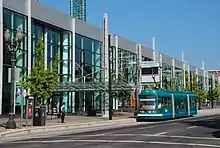
_in_2016.jpg.webp)
The Loop Service serves 52 stations, 24 of which are shared with the NS Line.[65] Each platform is equipped with a ticket vending machine, real-time display system, and line information signs.[66] All stations are accessible to users with limited mobility.[67] Connections to MAX Light Rail are available at ten stops across the line.[68]
| Station | Neighborhood | Connections and notes[65] | |
|---|---|---|---|
| A Loop(clockwise) | B Loop(counterclockwise) | ||
| — | Northwest 10th & Northrup | Pearl District | NS Line |
| — | Northwest 11th & Marshall | — | |
| Northwest 9th & Lovejoy | — | — | |
| Northwest 10th & Johnson | Northwest 11th & Johnson | NS Line | |
| Northwest 10th & Glisan | Northwest 11th & Glisan | NS Line | |
| Northwest 10th & Couch | Northwest 11th & Couch | NS LineServes The Armory, Powell's City of Books | |
| Southwest 10th & Alder | Southwest 11th & Alder | Downtown | NS Line |
| Central Library | Southwest 11th & Taylor | NS Line; | |
| Art Museum | Southwest 11th & Jefferson | NS LineServes Portland Art Museum | |
| Southwest 10th & Clay | Southwest 11th & Clay | NS Line | |
| Southwest Park & Mill | Southwest Park & Market | NS LineServes South Park Blocks | |
| — | Southwest 5th & Market | NS LineServes Portland State University | |
| PSU Urban Center | Southwest 5th & Montgomery | NS Line; | |
| Southwest 3rd & Harrison | NS Line | ||
| Southwest Harrison Street | NS LineServes RiverPlace | ||
| Southwest River Parkway & Moody | NS LineServes RiverPlace | ||
| Southwest Moody & Meade | South Waterfront | NS Line; | |
| OMSI | Central Eastside | ||
| Southeast MLK & Mill | Southeast Grand & Mill | — | |
| Southeast MLK & Hawthorne | Southeast Grand & Hawthorne | — | |
| Southeast MLK & Taylor | Southeast Grand & Taylor | — | |
| Southeast MLK & Morrison | Southeast Grand & Morrison | — | |
| Southeast MLK & Stark | Southeast Grand & Stark | — | |
| Northeast MLK & East Burnside | Southeast Grand & East Burnside | — | |
| Oregon Convention Center | Northeast Grand & Hoyt | Lloyd District | |
| Northeast Oregon & Grand | Northeast Grand & Holladay | — | |
| Northeast 7th & Holladay | Northeast Grand & Multnomah | ||
| Northeast 7th & Halsey | — | — | |
| Northeast Weidler & Grand | Northeast Grand & Broadway | — | |
| Northeast Weidler & 2nd | Northeast Broadway & 2nd | — | |
| North Weidler & Ross | North Broadway & Ross | — | |
References
- "Portland Streetcar Ridership Counts, July 2015 - Present (By Fiscal Year)" (PDF). Portland Streetcar, Inc. September 2018. Retrieved March 18, 2019.
- Stewart, Bill (July 31, 1997). "Streetcars will return to Portland; the city council votes to pay for a westside loop of streetcars described as cheaper than light rail". The Oregonian. p. D1.
- Stewart, Bill (January 22, 1998). "Closure launches bridge make over". The Oregonian. p. D2.
- Stewart, Bill (April 24, 1999). "Wait no more: Sunday makrs Hawthorne Bridge reopening". The Oregonian. p. C1.
- "Lloyd District Development Strategy" (PDF). Portland Development Commission. July 27, 2001. Retrieved August 29, 2019.
- Leeson, Fred (July 17, 2001). "Portland grand plans works in works in Lloyd District". The Oregonian. p. B3.
- Leeson, Fred (July 20, 2001). "New streetcar route follows different mission". The Oregonian. p. 24.
- Leeson, Fred (July 13, 2001). "Vision for Rose Quarter outlined". The Oregonian. p. A1.
- Leeson, Fred (February 17, 2003). "Streetcar officials seek Eastside desire". The Oregonian. p. E2.
- "Eastside Streetcar Alignment Study" (PDF). Portland Office of Transportation. June 25, 2003. Retrieved March 11, 2020.
- Leeson, Fred (June 6, 2003). "Streetcar backers propose loop through Inner Eastside". The Oregonian. p. D2.
- Stern, Henry; Nkrumah, Wade (June 26, 2003). "City Council watch". The Oregonian. p. C2.
- Mortenson, Eric (May 2, 2008). "Panel realigns route of new light-rail span". The Oregonian. p. D1.
- Portland Streetcar Loop Development Strategy (Report). Portland Office of Transportation. April 14, 2008. Retrieved April 9, 2020.
- Portland Streetcar Loop environmental assessment: Finding of no significant impact (PDF) (Report). Metro. July 9, 2008. Retrieved April 9, 2020.
- McGrain, Maureen (July 28, 2006). "Metro says yes to expansion for streetcar". Portland Business Journal. Retrieved May 20, 2009.
- Mayer, James (September 7, 2007). "Streetcar extension gets green light". The Oregonian. p. D1.
- Streetcar Loop Project Before-and-After Study (2016) (PDF) (Report). Federal Transit Administration. 2016. Retrieved April 8, 2020.
- Mesh, Aaron (August 22, 2012). "Slow Ride". Willamette Week. Retrieved August 29, 2012.
- "Portland Streetcar Loop fact sheet (May 2010)" (PDF). Portland Streetcar, Inc. Archived from the original on August 21, 2010. Retrieved August 30, 2010.CS1 maint: unfit URL (link)
- Pope, Charles; Rivera, Dylan (April 30, 2009). "Feds approve $75 million for streetcar expansion". The Oregonian. Archived from the original on October 5, 2012. Retrieved September 10, 2012.CS1 maint: unfit URL (link)
- "Feds give $75 million for Oregon streetcar". Portland Business Journal. April 30, 2009. Retrieved September 10, 2012.
- Hamilton, Don (August 5, 2005). "Iron firm forges streetcar desire". Portland Tribune. Archived from the original on March 31, 2012. Retrieved April 4, 2020.
- "Oregon Iron Works gets contract for streetcar". Portland Business Journal. January 26, 2007. Retrieved December 19, 2012.
- MacKinnon, Merry (May 13, 2009). "Streetcars soon to be made in Oregon". Portland Tribune. Archived from the original on June 10, 2020. Retrieved June 10, 2020.
- Redden, Jim (June 13, 2012). "Streetcar on a roll, but not just yet". Portland Tribune. Archived from the original on August 4, 2019. Retrieved May 14, 2020.
- Rivera, Dylan (August 14, 2009). "Portland inks $20 million deal for locally made streetcars". The Oregonian. Archived from the original on 17 August 2009. Retrieved June 4, 2019.
- Baer, April (June 25, 2009). "Construction Begins On Eastside Streetcar Loop". Oregon Public Broadcasting. Retrieved April 2, 2020.
- Carinci, Justin (February 17, 2009). "Stacy and Witbeck wins streetcar contract". Daily Journal of Commerce. Retrieved April 10, 2020.
- Carter, Dan (February 9, 2010). "Streetcar Loop Project". Daily Journal of Commerce. Retrieved April 2, 2020.
- Rose, Joseph (July 18, 2010). "Portland – Broadway Bridge will close". The Oregonian.
- Rose, Joseph (September 2, 2010). "Two lanes, sidewalk of Portland's Broadway Bridge set to reopen Saturday". The Oregonian. Archived from the original on October 12, 2010. Retrieved June 10, 2020.
- Rose, Joseph (July 5, 2010). "Streetcar work shutting down Broadway Bridge". The Oregonian. p. A10. Retrieved November 9, 2013.
- Vorenberg, Sue (February 18, 2011). "Streetcar work wraps up on Broadway Bridge". Daily Journal of Commerce. Retrieved April 3, 2020.
- Vorenberg, Sue (November 5, 2010). "Pearl streets reopen with changed traffic patterns". Daily Journal of Commerce. Retrieved April 3, 2020.
- Carter, Dan (December 22, 2010). "Portland Streetcar flyover bridge near OMSI". Daily Journal of Commerce. Retrieved April 3, 2020.
- Webber, Angela (July 20, 2011). "Eastside streetcar loop will be delayed, number of cars reduced". Daily Journal of Commerce. Retrieved April 3, 2020.
- Schmidt, Brad (July 19, 2011). "Portland's $148.3 million eastside streetcar project delayed five months, includes five streetcars instead of six". The Oregonian. Retrieved September 10, 2012.
- "Streetcar History". Portland Streetcar. Archived from the original on December 3, 2013. Retrieved September 7, 2015.CS1 maint: unfit URL (link)
- Thompson, Richard (2015). Slabtown Streetcars. Arcadia Publishing. ISBN 1439652716.
- Schmidt, Brad (July 19, 2011). "Portland's $148.3 million eastside streetcar project delayed five months, includes five streetcars instead of six". The Oregonian. Retrieved September 17, 2015.
- "Portland Streetcar Introduces 'Central Loop' Service". Passenger Transport. American Public Transportation Association. October 5, 2012. Retrieved January 26, 2014.
- Rose, Joseph (September 21, 2012). "Portland Streetcar's eastside loop gets off to hobbled start Saturday". The Oregonian. Retrieved September 7, 2015.
- Schmidt, Brad (June 12, 2013). "New streetcar rolls out in Portland". The Oregonian. p. B1. Retrieved August 6, 2013.
- "Portland Streetcar Introduces 'Central Loop' Service". Passenger Transport. American Public Transportation Association. October 5, 2012. Retrieved September 8, 2015.
- Giegerich, Andy (October 31, 2012). "Eastside streetcar: Carrying the wait". Portland Business Journal. Retrieved April 5, 2020.
- "Portland Streetcar System Concept Plan: A Framework for Future Corridor Planning and Alternatives Analysis". Portland Bureau of Transportation. September 9, 2009. Retrieved April 10, 2020.
- Streetcar Route Map (2012) (PDF) (Map). Portland Streetcar, Inc. September 2012. Archived from the original on October 21, 2012. Retrieved October 1, 2012.CS1 maint: unfit URL (link)
- Pyrah, Alli (July 29, 2014). "Watch Tilikum Crossing being built in 1 minute, 37 seconds". Portland Business Journal. Retrieved May 14, 2020.
- "Traffic Advisory: Streetcar track work to close lanes on SE MLK Blvd Aug. 5-9; buses to replace streetcar service during construction" (Press release). Portland Bureau of Transportation. August 9, 2013. Retrieved April 10, 2020.
- "Close the Loop Streetcar". Portland Bureau of Transportation. Retrieved April 10, 2020.
- "Portland Streetcar Loop Service". Portland Streetcar, Inc. Archived from the original on August 6, 2015. Retrieved September 7, 2015.CS1 maint: unfit URL (link)
- 2018 Regional Transportation Plan: Coordinated transportation plan for seniors and people with disabilities (PDF) (Report). Metro. December 6, 2018. Retrieved April 8, 2020.
- "Tilikum Crossing, Bridge of the People, brings new connections and new options in 2015" (PDF). TriMet. June 2014. Retrieved April 8, 2020.
- Vincent, John M. (September 8, 2015). "Routes, fares change with expanded streetcar service". Portland Tribune. p. A3. Archived from the original on November 28, 2015. Retrieved August 23, 2019.
- A Loop schedules:
- "A Loop – Weekday Schedule" (PDF). Portland Streetcar, Inc. Retrieved April 8, 2020.
- "A Loop – Saturday Schedule" (PDF). Portland Streetcar, Inc. Retrieved April 8, 2020.
- "A Loop – Sunday Schedule" (PDF). Portland Streetcar, Inc. Retrieved April 8, 2020.
- B Loop schedules:
- "B Loop – Weekday Schedule" (PDF). Portland Streetcar, Inc. Retrieved April 8, 2020.
- "B Loop – Saturday Schedule" (PDF). Portland Streetcar, Inc. Retrieved April 8, 2020.
- "B Loop – Sunday Schedule" (PDF). Portland Streetcar, Inc. Retrieved April 8, 2020.
- "Portland Streetcar sees record ridership in April". Portland Streetcar, Inc. May 15, 2018. Retrieved March 20, 2019.
- Streetcar Route Map (PDF) (Map). Portland Streetcar, Inc. September 2015. Archived from the original on September 14, 2015.CS1 maint: unfit URL (link)
- "Towing Procedures for Portland Street Tows". City of Portland. November 27, 2015. Archived from the original on April 15, 2020. Retrieved April 14, 2020.
- Google (April 6, 2020). "SE Water/OMSI (Streetcar)" (Map). Google Maps. Google. Retrieved April 6, 2020.
- "OMSI/SE Water Ave Station". TriMet. October 2014. Retrieved April 10, 2020.
- Google (April 10, 2020). "OMSI/SE Water MAX Station" (Map). Google Maps. Google. Retrieved April 10, 2020.
- "South Waterfront/SW Moody Ave Station". TriMet. October 2014. Retrieved April 10, 2020.
- "Maps + Schedules – Portland Streetcar". Portland Streetcar, Inc. Retrieved March 18, 2019.
- "Ride Guide". Portland Streetcar, Inc. Retrieved April 1, 2019.
- "Accessibility Info". Portland Streetcar, Inc. Archived from the original on February 1, 2012. Retrieved June 6, 2019.CS1 maint: unfit URL (link)
- Portland City Center and Transit Mall (PDF) (Map). TriMet. Archived from the original (PDF) on February 10, 2019. Retrieved July 30, 2018.
